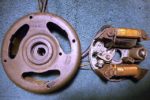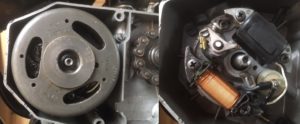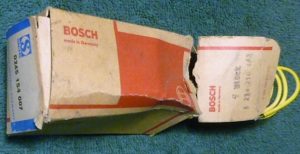Select:
Information
Welcome. The magneto has two separate functions, 1) produce sparks for ignition, 2) produce electric power for lights.
1) Ignition Pulses: The magneto produces precisely timed pulses, which are transformed into sparks by an internal or external coil.
2) Lights Power: The lights power is normally 6 volts alternating current (6V AC). Normally the correct bulbs are used, and none are burned out. But under certain circumstances the voltage can be less, like 3 volts, or more, like 10 volts. When two or more bulbs share the same generator wire, and one of the bulbs burns out, the others will get an over-voltage, like 8 or 10 volts, become instantly bright and soon burn out. The total watts of the bulbs has to match the watts of the generator, for the voltage to be 6 volts. If the bulb watts is more, then the voltage is less so the light is dim. Bosch makes magnetos with extra generator coils, one for each light, to eliminate the over-voltage and under-voltage problem.
Magneto-Generator History: Moped magnetos changed as moped lights changed over the years. In the 1960’s not many countries worldwide had laws about the brightness of moped lights or the placement of switches and buttons. Mopeds did not have brake lights or extra generator coils for them. A typical 1960’s moped had a 15 watt headlight and a 2 watt tail light, both powered by the same 17 watt generator coil.
Starting in 1972, the USA adopted safety standards for motorcycles and motor-driven cycles (Mopeds had not been defined yet). Lights, rims, brakes and tires had to be US DOT approved. Tail lights had to shine to the sides. Engine stop switches/buttons had to be reachable by the right thumb, while horn and light switches had to be reachable by the left thumb. Switches and fuel petcocks had to be labeled and say what they do. Brake lights were required.
Then in historic 1976 the USA adopted safety standards specifically for mopeds and motorized bicycles. The brake light had to be brighter (at least 10 watts) and not cause the headlight to get dimmer.
 Internal and External Ignition Ground: To supply the required independent brake light power, there were two solutions. 1) Internal Ignition Ground, where the ignition source coil internal ground was kept the same, and an extra generator coil was added or 2) External Ignition Ground, where the ignition source coil internal ground was relocated to outside of the engine and used as a brake light power source. Bosch made both magneto types, in both sizes 80 and 90 mm.
Internal and External Ignition Ground: To supply the required independent brake light power, there were two solutions. 1) Internal Ignition Ground, where the ignition source coil internal ground was kept the same, and an extra generator coil was added or 2) External Ignition Ground, where the ignition source coil internal ground was relocated to outside of the engine and used as a brake light power source. Bosch made both magneto types, in both sizes 80 and 90 mm.
Swapping Flywheels: Nearly identical flywheels can have different timing angles. That means the woodruff key groove is at a different angles to the “bump” on the points cam. So you can swap flywheels but your ignition timing would be way off. more to follow…
Over 200 quality Bosch magneto parts attended the reunion.
The 80 mm “small” ones are left, the 90 mm “big” ones are right.
Not shown, the many engines and bikes the used parts came from.
It don’t come easy. Parts catalogs list the bike maker part numbers, but most do not also give the component maker part number.
Bosch coil part numbers come from the packaging of new coils. Sometimes empty ripped-up original boxes are pieced back together, to get the part number translation, such as Sachs-to-Bosch. 1970’s-80’s armatures also have the last 3 digits stamped on.
Bosch stator part numbers are on the back of the base plate. The first 7 digits are cast in, the same for all. The last 3 digits of the stator assembly part number are stamped on by the factory when the coils are attached.
Bosch stator identification: Each engine has a different and unique rubber grommet for the wires to pass through. A pile of used moped stators can be sorted by grommet type, which is engine type. The ones missing grommets can be matched to the grommet ones by stator part number. This is done without any books or manuals. Specifications, illustrations, or part numbers from books, manuals, internet photos are additional forms of ID. All forms of ID must agree.



